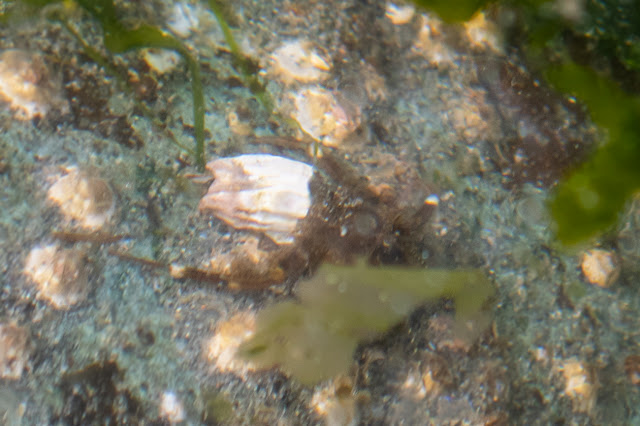Another visitor came to my light.
 |
| Field cricket, Gryllus spp., female. |
Males have two cerci (my guide says "pointy things") at the back of the abdomen. Females, besides, have an ovipositor, the egg-laying organ.
 |
| Head view. Interesting "grabbers" at the mouth. |
I tried to capture her to put her outside, but she was too fast for me and hid behind a cabinet. Shortly afterwards, another cricket started to chirp just outside the window and kept it up off and on all night. Males chirp, females don't. I hope she went out to join him.
Do crickets fly? Or did she have to climb up the wall to find her mate? Looking at the photos, I see her tiny wing covers; are there full-sized wings underneath, all folded up?
Some species of field crickets have fully-formed wings and do fly. Others, also among the field crickets, are flightless. Which is she?
I found a photo with those stubby wing covers, but this cricket,
Gryllus campestris, was in Czechoslovakia. I couldn't find any near here. E-Fauna, here in BC, has another field cricket,
G. pennsylvanicus, but this one has full-sized wings. And a much longer ovipositor.
Maybe I'll see her again. And I'll ask her; "can you fly?"
~~~~~~~~~~~~~~~~~~~~~~~~~~~~
Llegó otra visita atraída por mi lámpara de noche.
Fotos: Un grillo hembra, Gryllus spp.
Los machos tienen dos cercos (apéndices largos en la extremidad del abdomen). Las hembras, además, tienen un ovipositor, un órgano usado para depositar los huevos.
Traté de capturarla para sacarla afuera, pero se escondió rapidamente tras un gabinete. Poco después, un grillo empezó a cantar afuera de la ventana, y siguió esporádicamente toda la noche. Los machos cantan, las hembras no. Ojalá mi visitante se haya ida a acompañar al cantante.
¿Vuelan los grillos? ¿O tuvo que subir la pared en pie para buscar su pareja? Mirando las fotos, vio los cobertores de sus alas, muy pequeñas; ¿tendrá debajo de ellos alas completas todas dobladas?
Algunas de las especies de grillos de campo tienen alas perfectas y si vuelan. Otras, también llamadas grillos de campo, no pueden volar. ¿A cual grupo pertenece esta?
Buscando, buscando, encontré una foto con esos elitros cortos, pero este, Gryllus campestris, estaba en Checoslovakia. No pude encontrar ninguno cerca de aquí. En E-Fauna, hay otro grillo de campo, G. pennsylvanicus, pero este tiene alas grandes. Y un ovipositor mucho más largo.
Puede ser que la vuelva a ver. Y entonces, le preguntaré — ¿Puedes volar?























































